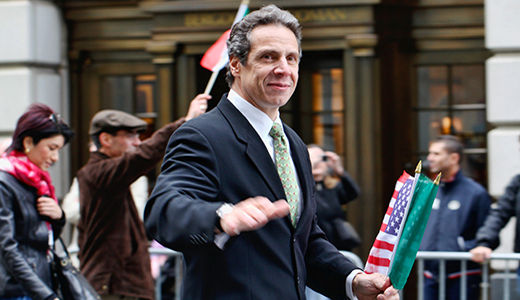
NEW YORK – Though there are a total of seven candidates for governor in the upcoming New York governor race, only two can be taken as serious candidates.
This was exemplified during the Oct. 18 gubernatorial debate at Long Island’s Hofstra University. All the candidates appeared, and the vast majority came across as part of the far-out fringe – including the GOP’s nominee.
“Crazy” Carl Paladino, anti-gay, anti-immigrant, anti-abortion, anti-union – it might actually be easier to say anti-everything – appeared as the candidate of the Republican and Conservative Parties, backed by the tea party movement. Though he used less gay-bashing, hate-mongering vitriol than he’s known for, he still offered a plan for this state that would slash education and Medicaid (which he continued to mix up with Medicare), as well as other essential services, all the while laying off workers and attacking the labor movement. His extreme right-wing policies show that the Republican Party itself, at least in this state, has become a far-right radical organization.
A number of minor party candidates, including those of the Anti-Prohibition Party, Libertarian Party and the Green Party, appeared on the platform. Though they offered some entertainment value – especially Anti-Prohibition’s “Manhattan Madam” Kirstin Davis, who suggested that one proposal would cause businesses to “leave this state faster than Carl Paladino at a gay bar” – they all offered either little substance or, in the case of the Libertarian candidate, policies even worse than those of Paladino.
Among the fringe candidates, a special stand out was Jimmy McMillan of the Rent is Too Damn High Party. He was good on a couple of issues, most obviously the rights of renters, but also gay marriage (“If you want to marry a shoe, we will marry you,” was his response to the question of whether he’d allow same-sex marriages in the state.) While that, along with his wildly retro biker-style handlebar moustache-beard might cause some people to consider voting for him, the fact that he is a raving anti-Semite should turn people off.
Theatrics aside, the substance came from the only two people on stage who seem fit to be governor of New York State: Andrew Cuomo, running on the Democratic, Independence and Working Families Party lines; and Charles Barron, the current city council member and candidate of the newly-formed Freedom Party.
And, in that debate, Barron won, hands down. Cuomo put forward the same agenda, essentially, as David Paterson, the current governor. He agreed that the state is “addicted to spending,” and spoke mainly of how important it is to curtail government waste and fraud. To be sure, these are important issues, and Cuomo had some good proposals for consolidation. But at the same time, he put forward much of the union-breaking rhetoric that Paterson and all the Republicans have, and he also talked about the “dysfunction” in Albany, failing to distinguish who were the “good guys” from the “bad guys.”
Barron, though, was good on nearly all issues. His talk of empowering racially and nationally oppressed communities was refreshing, given Cuomo’s so far racially insensitive campaign. Barron also helped the debate by bringing forward issues that affect all working families and countering much of the nonsense put forward by Paladino and, in a slightly nicer form, Cuomo himself.
Barron cogently argued that, while there is waste and fraud, simply slashing the budget won’t get rid of it; in fact, it will hurt the state more than the deficits. Cutting the budget means laying off workers, which puts a downward pressure on the economy as a whole. Also, Barron made the point (as did the Green candidate) that a progressive income tax would bring billions of dollars into the state’s coffers – eliminating the deficit altogether, most likely permanently.
Progressives in New York, therefore, have two real choices: Andrew Cuomo or Charles Barron. It appears highly unlikely that Paladino has any chance of winning, so the threat of Barron acting as a spoiler seems to be nil.
The problem, however, lies with the fate of the state’s main progressive political party, which unites the labor movement and community organizations into a political force: the Working Families Party. This is an overwhelmingly multiracial, working-class party that stands for the same core values that Charles Barron himself was pushing. They, however, endorsed Cuomo, basically out of necessity.
The thinking behind this was: it’s important to defeat the Republicans, and the only person who can win is Andrew Cuomo. Therefore, voting for him is necessary, but doing it on the WFP line will send a clear message that policies that favor working people and the racially and nationally oppressed better be coming down the pike.
Though Paladino is no longer considered a threat, it is still necessary for the WFP to rack up 50,000 votes in the gubernatorial election. That is the magic number; if they receive less, the party will lose its qualification to be automatically on the ballot in upcoming elections. The same is also the case of the Freedom Party, so progressives have to make a choice not based on the candidate, but on the party.
Undoubtedly, given New York’s fusion-style of voting, in which multiple parties can endorse the same candidate, a party that has as its expressed, main goal that of empowering the African American, Asian and Latino communities could only be beneficial. At the same time, the WFP has been around longer, represents almost all of labor, and has a long track record of fighting for working New Yorkers – and against racism. Many progressives argue that the WFP has to be preserved, and that the Freedom Party, though laudable, because it is a newer political formation is riskier and could detract votes from the WFP, potentially keeping both off the ballot.
Therefore, these progressives argue, it makes sense to vote for Cuomo and the rest of the Democratic slate on the WFP line – but to keep an eye on the Freedom Party as well.
Image: Andrew Cuomo saybaryo // CC BY-ND 2.0












Comments